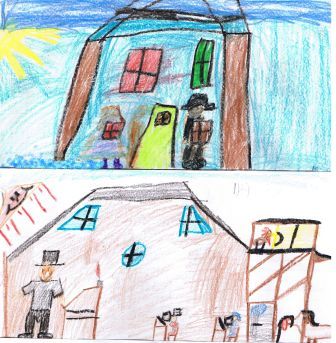 Every Monday, 1,500 elementary students link their minds to the world and to career and service opportunities that may well fuel long-term interests. On one recent chilly Monday during S.K.’s Community Learning Program, the natural world of Aquidneck Island was delivered to students through scientific findings on how animals survive and thrive.
Every Monday, 1,500 elementary students link their minds to the world and to career and service opportunities that may well fuel long-term interests. On one recent chilly Monday during S.K.’s Community Learning Program, the natural world of Aquidneck Island was delivered to students through scientific findings on how animals survive and thrive.“Since I can’t bring our sanctuary to you,” begins Yvette Haughney, AmeriCorps member and naturalist for a well-known preserve and vibrant environmental education center, “I’ve brought some BIO FACTS instead.”
“When we hike at Norman Bird Sanctuary, we look at rocks to discover geological facts about Rhode Island and world history. We investigate insects and fish to find out about the health of our water. From treetops to groundwater, we learn from our findings. Plant, animal and mineral BIO FACTS tell us a lot about survival.
“So you think snakes are slimy and have bones?” asked Yvette. A snake exoskeleton reveals, on the contrary, that “snake skin, like that of all reptiles, is dry, scaly and sheds. Do you think snakes can eat something as big as a mouse? Well, snakes have a special jaw that can swallow something three times their size!” (Just go ahead and try holding your hands behind your back while swallowing a basketball!)
A non-native loggerhead sea turtle skull with big eye sockets revealed another animal adaptation: living in salty water, the loggerhead has evolved a special gland under its eyes to expel extra salt from inside its body. The smooth and flat juvenile green sea turtle shell helps it move protectively. Unlike RI’s snapping turtles, grooved of shell and lazy in motion, this
 turtle lies flat to flee swiftly from its predators.
turtle lies flat to flee swiftly from its predators.“Our next friend gets scared around loud noises. He may have no backbone, but he’s no coward! With eight legs and eight eyes, Ocho the Mexican red knee tarantula was named “eight” in Spanish. You won’t find him in RI; his natural habitat is deserts and rainforests, but Ocho was someone’s “cool” pet before his care became too much. BIO FACTS: he flicks hair from his body when angry to make other animals sneeze. And he sheds his exoskeleton when it gets too tight, emerging with bright, orange-red ‘knees’ on his jointless legs to attract mates.
The next creature’s reaction when frightened can be pretty gross. Micah the barred owl, with dark striping through his feathers, flies faster by releasing droppings to lighten his load. “Micah might have hit a car; the blow to his head was so traumatic that he was taken to a vet, probably no longer able to survive in the wild.” He now tends to pull out his own feathers, making it hard to fly. Owls naturally lose feathers: growing baby owls shed soft down, and adults grow a showy spring coat during mating season. The barred owl often can be heard calling in the wild—“Who cooks for you, who cooks for you all?...”
 Micah feeds on store-bought frozen mice. Enrapt, students learned that the bones, fur and other remains from a good dinner are ground up and rolled into pellets in his gizzards before being upchucked. “Owl pellets are great to study, but they’re not clean—hands off if you find one!” So the next time you scare an owl and it poops, or a tarantula sticks you with hair, or a snake swallows a mouse 3x its size, you’ll know these are survival mechanisms. What BIO FACTS in your world would show an alien how you survive? How do YOU protect yourself, eat and attract new friends?
Micah feeds on store-bought frozen mice. Enrapt, students learned that the bones, fur and other remains from a good dinner are ground up and rolled into pellets in his gizzards before being upchucked. “Owl pellets are great to study, but they’re not clean—hands off if you find one!” So the next time you scare an owl and it poops, or a tarantula sticks you with hair, or a snake swallows a mouse 3x its size, you’ll know these are survival mechanisms. What BIO FACTS in your world would show an alien how you survive? How do YOU protect yourself, eat and attract new friends?A big thank you to CLP for bringing the Norman Bird Sanctuary to S.K.’s elementary schools. Perhaps sharing the skills of the naturalist with budding scientists will help them learn about how humans survive in this ever-changing world.













.JPG) “Reuse it!”
“Reuse it!”































+SKLT.jpg)




+SKLT.jpg)




